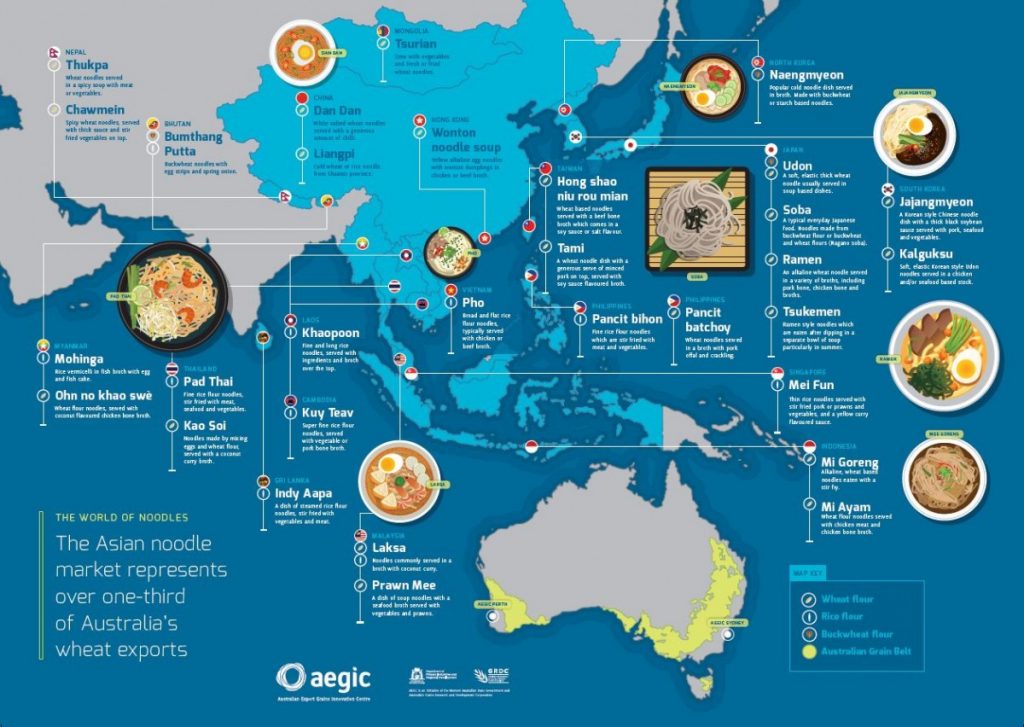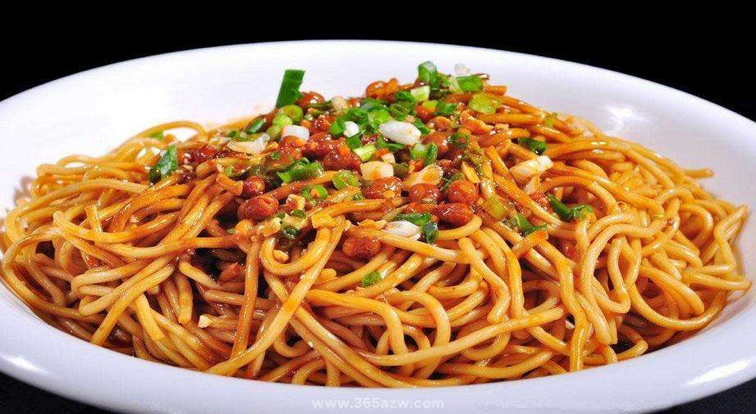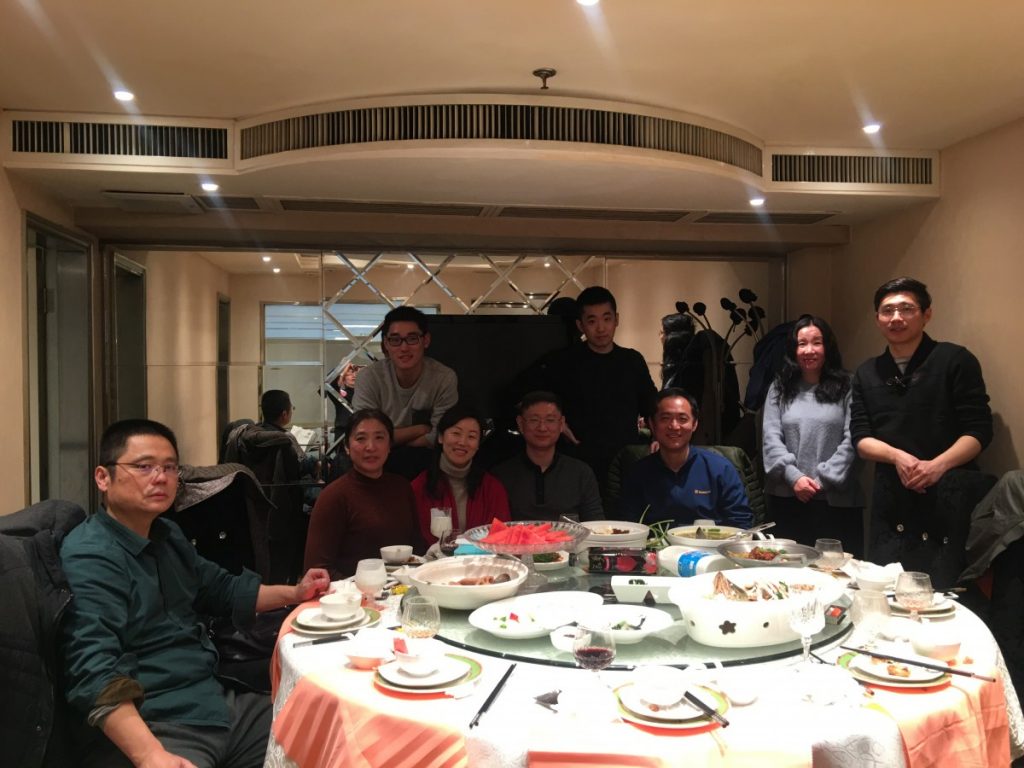Ryan Xu
Cultural Significance of Chinese Noodles
Having a history of over four thousand years, the noodle is a significant and inseparable part of the Chinese culture. Despite the fact that the Chinese people have eaten noodle dishes for thousands of years, the ingredients and cooking methods of noodle dishes varied greatly throughout the history of China, as well as in the different regions of China. The noodle has the capability to adequately reflect the history, regional differences, social changes, traditional values and cultural identity of China.
Chinese noodles have more than two thousand different kinds of cooking methods, and have influenced the noodle culture of the entire East Asian region, including countries such as Korea, Japan, Vietnam, Mongolia, Indonesia and Thailand. However, the noodle, as well as the main ingredient for making noodles, wheat, did not originate from China. Wheat was first cultivated in the Mesopotamian plains about nine thousand years ago. Six thousand and five hundred years after the birth of wheat, wheat planting technology, together with noodle making techniques, began to spread from the Middle East to the Mediterranean, across the Balkans and the Alps, and eastward through Central Asia to China. Therefore, the “Silk Road,” which started from Chang’an and passed through Gansu, Xinjiang, Central Asia, Western Asia and even Mediterranean countries, was also called the “Noodle Road”. Arab traders traveling along the Silk Road carried dough with them as dry food. Before eating the dough, they would divide it into small pieces, roll them into strips, dry them and roast them on fire. Therefore, these Arab traders created the earliest form of noodles. The noodles they made entered the mainland of China along the Silk Road and began to flourish in the Central Plains of China. However, Chinese people who lived in the Central Plains liked to eat soup dishes, so they would boil noodles in water. Another important representation of the Chinese food culture, chopsticks, were also created in this process of boiling noodles.
Although China was not the originating place for noodles, the earliest form of noodles was discovered in a village in Northwest China. The uncovered noodles was more than four thousand years old, which provided evidence that Chinese had a culture of eating noodles for over four thousand years. In ancient China, noodles were originally called bing, which means “cake” in the modern Chinese language. The noodle had different shapes, names and cooking methods in different time periods of Imperial China. According to the Han dynasty scholar Liu Xi in his book Shi Ming, the noodle was called suo bing during the Han dynasty. Later, during the Northern Wei dynasty, shui yin bing, which literally meant “water induced cakes,” was documented in the book Qi Min Yao Shu, written by the scholar Jia Sixie. In his descriptions, shui yin bing was a kind of boiled noodle that was about a foot long and as thin as “leek leaves.” During the Tang dynasty, a kind of noodle dish called leng tao, or cold noodles, gained popularity among the Chinese people. Cold noodles are still popular among Chinese people today, and it is sold in noodle restaurants all around the country, especially during the summertime, when the weather is hot outside. However, instead of its ancient name leng tao, cold noodles are now called liang mian or leng mian. Noodle dishes had even more variations during the following Song dynasty. During the time, food markets and restaurants served over ten different kinds of noodle dishes. Two of the most famous dishes were cha rou mian and jiao tou mian. Jiao tou mian was a type of noodle dish that had gravy with meat or vegetables poured over it, and even until now, it is still a famous and popular noodle dish in southern China. During the later dynasties, new cooking techniques and methods for noodles were invented, and thus creating new noodle dishes. Some of the most famous ones were gua mian during the Yuan dynasty, pulled noodles and sliced noodles during the Ming dynasty, and yi fu mian during the Qing dynasty.
Even though people from almost every region in China have a culture of eating noodle dishes, noodle dishes in northern China and southern China are vastly different in noodle making techniques, ingredients and taste. Even the Chinese character for the noodle, mian, has different meanings in northern China and southern China. To the northern people, mian usually means flour, while to the southern people, mian refers to processed noodles. Noodles in the south are mainly made of flour and duck egg yolk, while noodles in the north are mostly made of wheat flour and alkaline water. Comparing to southern noodles that use egg yolk, northern noodles that use alkaline water can be digested more easily, and therefore, for the northern Chinese people, noodles are considered the main and staple food. Because noodles are the main food in the north, the quality and quantity of noodle dishes are more important in the north than in the south. Northern people often season their noodles with green onions, raw garlic and coriander. Since the climate in the north is also much colder than the climate in the south, northerners would also use large amounts of cooking oil and salt in making the noodle dishes, so that they can keep their bodies warm when eating the noodles. Northerners would also eat noodles with mantou, bread or pancakes in order to fulfill their stomachs. On the contrary, southern Chinese people consider rice as their main and staple food, and noodles are only regarded as snacks. Therefore, noodle dishes in the south are usually much less in quantity than noodles dishes in the north, and seasonings such as ginger, garlic or coriander are usually not included in the dishes. Instead, southerners often season their noodles with soy sauce, pickles and vegetable oil. Therefore, the differences in noodle dishes can also represent the difference in the climates and traditions for the northern and southern Chinese people.
The cultural identity of China can also be found in the noodles, considering their interesting styles, meanings and background stories. Food plays a significant role in the Chinese culture, and among the numerous categories of Chinese foods, the noodle is one of the most representative of the Chinese traditional values, beliefs and cultures. Chinese people eat different kinds of noodles at different occasions, seasons and festivals. For example, it is the Chinese custom to eat the longevity noodles during birthdays, noodles with gravy when moving into a new house or at the time of a marriage, and dragon whisker noodles on the day of lunar February 2. There are also noodles with interesting stories associated with them, such as the “dutiful son’s noodle,” “dan dan noodles,” “sister-in-law noodles” and “old friend noodles.” (Zhang, Noodles: Traditional and Today, 210) These noodles reflected the love, dreams, care and friendship of the people who cooked the noodles. Therefore, each of these noodles is not only unique in cooking style and tastes, but is also special in its meanings and representations of the emotions of the people who cooked them. The interesting background stories of the various types of noodles reflect the important traditional Chinese values of filial piety, family relations, friendship, and care for others.
One of the most famous types of Chinese noodles is the Crossing-the-Bridge noodles, which is a rice noodle soup from the Yunnan Province. Crossing-the-Bridge noodles also has an interesting story associated with it. The story described a boy who was ordered by his father to study for the Imperial Exams in the cottage of an island, and the boy was not allowed to leave the island until his studies were completed. Since the island was far away from his house, and the story took place in the coldest months of the year, all the meals that the family cook had cooked for the boy would become cold and unpalatable when the meals reach the boy. After being troubled by this problem for a long time, the cook finally came up with an idea and invented a new type of noodle dish, Crossing-the-Bridge noodles, by adding an extra layer of hot chicken broth and chicken fat to the noodle soup. According to the story, the noodle was invented to have the capability of keeping warm for a long time under cold winds and temperatures, so that when the cook brings the noodle soup across the bridge to the boy who was studying for the imperial examinations, the noodle soup would still be hot and warm enough to eat. “ ‘It is too hot!’ he said, and began laughing. ‘I know,’ said the cook, nodding happily. ‘It is the fat that keeps out the wind, the cold, and the bad spirits. Now that you have the nourishment you need, learning will come naturally and gracefully.’ The boy ate the delicious soup with a hunger that he did not know he had as he watched the chef skipping like a child across the bridge back to his kitchen.” (Durack, Noodle, 183) Therefore, Crossing-the-Bridge noodles reflected the cleverness and mastery of the cook in cooking, as well as the love and care he had for the boy, and the passion he had for pleasing people with his food.
Similar to China, Italy is also a country where the noodle plays a significant role in the food culture. Italians also have a long history of eating noodles, and pasta is one of the most important and representative foods in the Italian culture. As the writer Massimo Montanari mentioned in his book Let the Meatballs Rest: And Other Stories About Food and Culture, “Pasta means Italy. No other food identifies more effectively the many parts of Italian gastronomy and, in a way, unites them.” (Montanari, Let the Meatballs Rest: And Other Stories About Food and Culture, 159) Montanari asserts that pasta can be viewed as a metaphor for both unity and variety in Italian food culture. Although pasta is a single type of food that can serve as the cultural identity for Italy, pasta is also divided into a large number of varieties, each of them unique in their shape, cooking methods, sauces, and purposes. Therefore, for the cultural identity for Italy, pasta can represent both unity and differences, which is important for Italy, a country that had a long history of being divided into different parts, but were eventually united together into one country. Although Italy is one single country now, many of its regions have different cultures and traditions, similar to the fact the each region has their unique style of making pasta. Therefore, noodles are important cultural representations in both China and Italy. Both Chinese noodles and Italian pasta can represent the history, geographic differences and traditional values and beliefs of the Chinese and Italian culture. However, the symbols of the Chinese noodle dishes themselves add an extra layer of complexity to the representation of Chinese culture, while Italy and Italian pasta, with reliance on the alphabet, might find it difficult to reach this layer of complexity.
To further investigate the cultural and social significance of Chinese noodles, I performed an interview with my father on the topic of noodles. The reason I chose to interview him was that he had lived in both China and the United States for extended periods of time, and had experience in the food cultures of both countries. Additionally, he also enjoyed eating noodle dishes, and had some insights in the food cultures of China and the United States. During my interview, I tried to explore two main themes, the reflection of Chinese society in noodles and the cultural influence of noodles on my interviewee. My father’s answers provided me enough information to answer these two questions. In our dialogue, he first mentioned two changes in the noodles, which were that instant noodles were once regarded as a high-quality food in the Chinese society, but not anymore, and that noodle dishes today were becoming more delicate and more expensive. He also mentioned two changes in his preference for noodles which reflected changes in the Chinese society. First, he mentioned that he could not afford to eat braised beef noodles and eel noodles when he was a child, but he ate them frequently now, and the second change was that he loved to eat instant noodles when he was young, but now he tried to avoid eating them as much as he could.
These changes that he mentioned all provided evidence for that fact that China’s economy had grown rapidly over the last several decades, and the Chinese people are becoming wealthier and have more money to spend on food. China has become one of the most rapidly growing economies in the world ever since the economic reform began in China in 1978. According to the World Bank, China’s poverty rate fell from 88% percent in 1981 to only 0.7% in 2015, and more than eight hundred and fifty million Chinese people have lifted themselves out of extreme poverty. Such rapid economic growth and dramatic social change are reflected in the changes and improvements in the ingredients, design, taste and price of noodle dishes in China, as well as the Chinese people’s impressions and relationship with noodles.
Transitioning to the other theme of how noodles have influenced my father culturally, I asked him about his thoughts on the noodles he usually ate when he was living in the United States. He answered that he did not like to eat the instant ramen noodles or macaroni and cheese, but he enjoyed some Western noodle dishes such as pasta and spaghetti. Since he grew up eating the traditional Chinese style noodles, he preferred Chinese noodles and noodles with soup base, and he would often make traditional Chinese style noodles by himself at home when he was living in the United States. Following this topic, I asked him directly how noodles had influenced him culturally. According to him, he thought that noodles had become one of the necessary foods for him, because he had eaten noodles for over forty years, ever since he was a child. Even when he was living in the United States, he would find Chinese restaurants and order some noodle dishes to eat, and he would also buy noodles from Chinese supermarkets and cook noodle dishes by himself at home. He even claimed that if he did not eat noodles for a long period of time, he would feel like something was missing from his life. Additionally, whenever he ate noodles now, especially traditional Chinese soup-based noodles, it would remind him of his childhood memories and his hometown. Therefore, from the thoughts and examples my father gave in this answer, I came to the conclusion that noodles were becoming a culturally inseparable part of him, and for him, noodles would represent his childhood as well as his hometown. Such influence is common for almost all the Chinese people, as the noodle is one of the favorite foods of the Chinese people for thousands of years, and it is also a large part of the Chinese diet, both in northern China and southern China.
Thus, the history of Imperial China and the differences in traditions between northern and southern China are reflected in Chinese noodles. The cultural identity of China and the important traditional Chinese beliefs and values can also be found in the background stories of different noodle dishes as well as in noodle itself. Through the interview I conducted, it is also evident that social changes and rapid economic growth in modern China are also mirrored in the changes of noodle dishes, and noodles have become a symbolic cultural representation for the Chinese people.
Works Cited
Chiu-Duke, Josephine, and Michael S. Duke, editors. “Food in Chinese Culture: The Han Period (206 B.C.E.–220 C.E.).” Chinese History and Culture: Sixth Century B.C.E. to Seventeenth Century, by Ying-shih Yü, Columbia University Press, NEW YORK, 2016, pp. 91–121. JSTOR, www.jstor.org/stable/10.7312/yu–17858.11.
Durack, Terry. “Crossing the Bridge.” Noodle, Pavilion, 2001, pp. 182–183.
Feng, Li. Early China: a social and cultural history. Cambridge University Press, 2013.
Fodor’s. Kelly, Margaret (ed.). Fodor’s China. Random House, 2009, p. 135. ISBN 978-1-4000-0825-4.
Montanari, Massimo. Let the Meatballs Rest: and Other Stories about Food and Culture. Columbia University Press, 2015, pp. 156–163.
“Overview”. Worldbank.org.
“Poverty Around The World — Global Issues”. Globalissues.org.
Regions of Chinese food-styles/flavours of cooking, University of Kansas.
Roach, John. “4,000-Year-Old Noodles Found in China”. National Geographic. 2005.
Zhang, Na, and Guansheng Ma. “Noodles, Traditionally and Today.” Journal of Ethnic Foods, vol. 3, no. 3, 2016, pp. 209–212., doi:10.1016/j.jef.2016.08.003.



